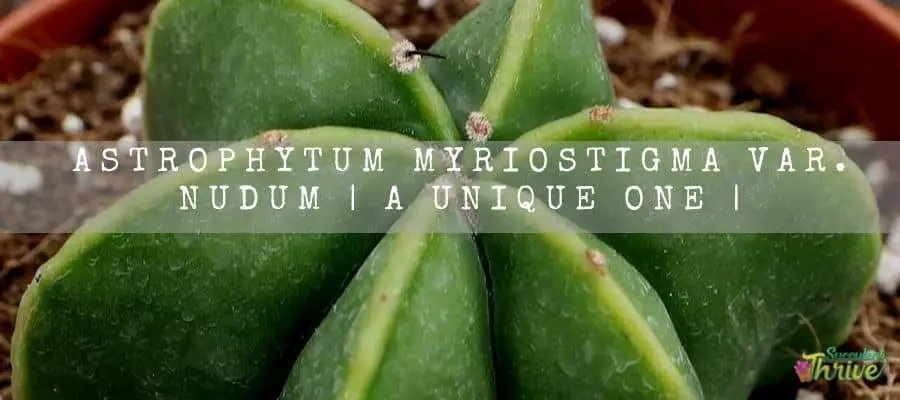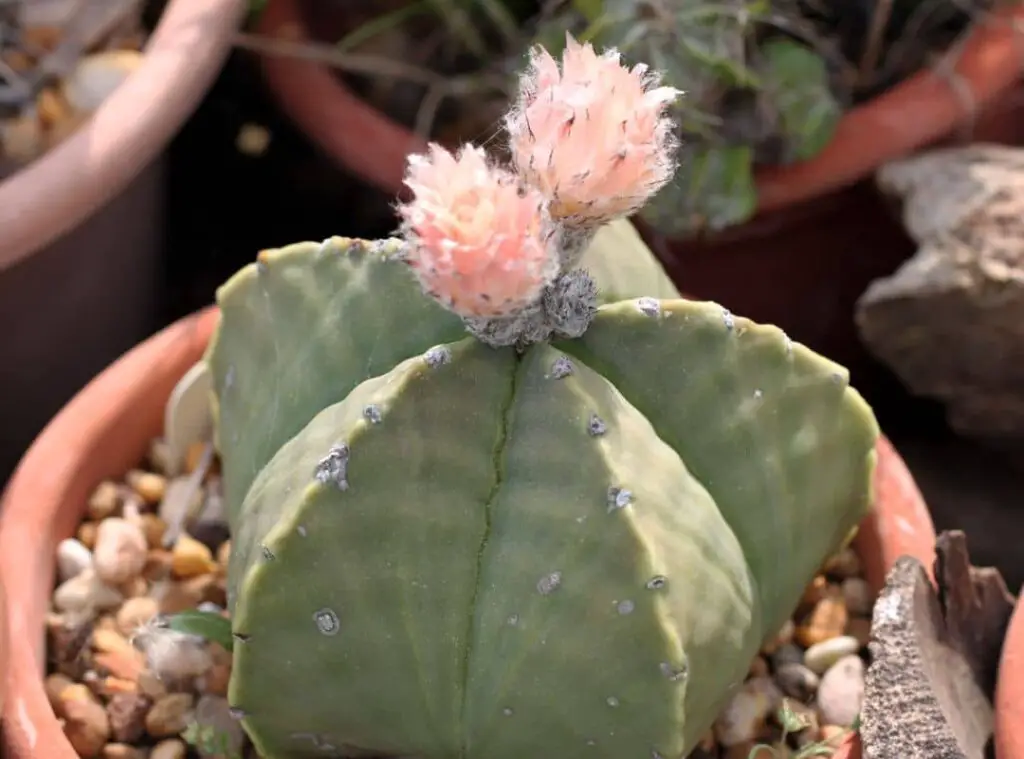Astrophytum myriostigma var. Nudum are rarely spotted cacti which usually form in a globular shape. They go by the common name nudum or Bishop’s Cap Cactus.

Astrophytum myriostigma var. nudum cactus originate from the state of San Luis Potosi ( Mexico). These cacti are hardy versatile plants which can perform well with minimum supervision from you.
So, Astrophytum myriostigma var. nudum cactus would be a great starter plant for anybody who is willing to start gardening.
They don’t contain thorns and usually require easy maintenance from you. Further, their exceptional geometric value tempts anybody to have these plants.
Let’s begin to find out about these precious plants and learn on how to provide the right care tips, the issues they may go through and on the propagation modes of these versatile cacti.
How do I identify astrophytum myriostigma var. nudum?
Astrophytum myriostigma var. nudum cactus look more like Astrophytum myriostigma plants. However, they come up with a stem which is more spherical.
That said, they would tend to become columnar as they mature. They would grow as tall as 3.3 feet in height. Further they would be 4 inches in width at maturity too.
Astrophytum myriostigma var. nudum cactus may develop ribs which would have narrow and somewhat twisted margins. Besides they may also consist of yellow orange variegations as well. This feature is what makes cactus livers go after these plants.
Usually, they would come up with 5 ribs and chances are that it may vary from 3 to 8. Astrophytum myriostigma var. nudum cactus usually grow spineless.
When you look at the plants from the above, they tend to take a look at stars.You could spot these cactus usually in a bright green, blue green , gray green color. The color formation would depend on the clones of the plants.
If I briefly touch on the flowering of the plants, Astrophytum myriostigma var. nudum cactus would emerge with pale, yellow-colored flowers during spring or in early summer.
Further chances are that they may also carry an orange gloom too. Astrophytum myriostigma var. nudum cactus blooms would be 5 cm in size.
However, you could identify these plants from their flower blossoming activity only if they are at least six years old.
Growth rate
Astrophytum myriostigma var. nudum cactus grow at a slow pace.
One look care guide
| Botanical Name | Astrophytum myriostigma var. nudum |
| Common Name | Bishop’s Cap Cactus |
| Plant Type | Cactus |
| Mature Size | 3.3 feet ( 1m) in height / 4 inches ( 10 cm) in diameter. |
| Sun Exposure | Full sunlight / partial shade |
| Soil Type | Well draining |
| Soil pH | Neutral |
| Bloom Time | spring or in early summer. |
| Flower Color | Pale yellow colored |
| Hardiness Zones | USDA hardiness zones 9a to 11b: from 20 °F (−6.7 °C) to 50 °F (+10 °C). |
| Native Area | Mexico |
| Toxicity | Non Toxic |
| Average price | 13 USD |

How do you take care of astrophytum myriostigma var. Nudum?
Light Requirement
The exposure to bright sunlight is a critical factor when it comes to providing the right growing conditions for them.
Ideally, they need to have full sunlight right throughout the year. Having said that, if the plants are young, you need to secure the plants from intense sunlight during the hottest hours of the day.
Plenty of sunlight in the morning will keep the plants happy and help them to grow firmly. However, if you have grown them in a glass room indoors, I suggest you provide some shade during the intensely scorching hours of the day.
That way you can protect the plants from sunburns. When you fulfill the sunlight requirements of the plants, it would make the plants look richer.
Temperature and humidity
Astrophytum myriostigma var. nudum cactus tend to grow well in warmer temperatures. They don’t prefer to get exposed to frost.
So, if the forecast is such where a hardy frost is predicted, you need to bring them indoors and grow them closer to grow lights.
Do not expose the plants for temperatures below 4 degrees Celsius. Humidity wise, I would say low humidity would work well with them as the exposure for high humidity levels would pave the way for root rot.
Is it cold hardy?
Astrophytum myriostigma var. nudum cactus have a cold tolerance up to 20 degrees Fahrenheit -6.7 degrees Celsius a bit not for too long.
Growth Zone
Astrophytum myriostigma var. nudum cactus grows hardy in USDA hardiness zones 9a to 11b: from 20 °F (−6.7 °C) to 50 °F (+10 °C).
Watering Requirement
Astrophytum myriostigma var. nudum cactus used to grow in hot and arid weather conditions. So many people don’t keep this in mind and tend to water them in excess quite often .
It could be one of the worst mistakes you could do for your plants as it would even kill the plants. So, you need to water them carefully and refrain from over supplying water.
If I further explain this, you can water them sparingly from March till October. That said, you need to be sure whether the soil is dry and only after then you need to resume watering the plants. Once the weather gets too colder, you need to cut back on watering.
Soil Requirement Type / pH
A good drainage is vital for the healthy growth of the Astrophytum myriostigma var. nudum cactus. In addition to that, ensure that the chosen soil mix is well aerating too.
Keep in mind that well-draining soil mix and infrequent watering would ensure that your beloved Astrophytum myriostigma var. nudum cactus are not going through root rots.
Ideally a succulent soil mix which comprises 70 %-80 % mineral grit would be ideal for this purpose. The mineral grit is such as coarse sand, pumice perlite etc.
Pot size Potting and Repotting
Pot which has a high porosity would work well with the Astrophytum myriostigma var. nudum cactus.
Besides that, it needs to have ample draining also so that it would move the excess water out from the pots. Astrophytum myriostigma var. nudum cactus are slow growing plants, so you may do this less often.
If the plants are outgrown from the pots, the ideal thing which you could do is transplant them. Further if you suspect your plants are experiencing a pest attack, you need to consider repotting them there too.
Where to Plant
Astrophytum myriostigma var. nudum cactus would need to have bright sunlight to maintain their best shape. So, you can plant them anywhere as long as you can fulfill the sunlight requirement

Fertilizer and time of year
These are note the type of cactus which demand frequent fertilization.
I suggest you use a fertilizer which has a low percentage of Nitrogen and a greater component of potassium and phosphorus. Bear in mind that you should feed them only in summer. Avoid applying the fertilizers during winter.
Flower
Astrophytum myriostigma var. nudum cactus develop inflorescences in yellow. They would flower during spring or in early summer.
Dormancy
Astrophytum myriostigma var. nudum cactus go into dormancy during winter.
Toxicity
There is no toxicity reported in these plants.
Common bugs and illnesses
High humidity levels and exposure for over watering would result in root rot of these plants. in fact, over watering could be the culprit for many other fungal and bacterial infections as well.
In addition to that , too soggy areas in the soil would be more favorable conditions for certain pests’ types as well. If you practice the right care tips, Astrophytum myriostigma var. nudum cactus would grow healthily and vigorously too.
How to propagate astrophytum myriostigma var. nudum
These cactus propagation could be done using the grafting method and the seeds propagation method. However, many people tend to use the seeds propagation method a lot.
Astrophytum myriostigma var. nudum benefits
Astrophytum myriostigma var. nudum cactus are ideal to grow in rockery settings, desert type landscaping. Not only that but also, they would make great additions in patios and in botanical gardens as well.
Conclusion
To sum up, Astrophytum myriostigma var. nudum cactus would be such excellent plants to have in your garden as well as indoors.
If you look after them properly, Astrophytum myriostigma var. nudum cactus would amaze you and bring so much glamor to the space irrespective of the place you grow them.
Read Next : Ariocarpus Fissuratus | A Cactus To Remember |
